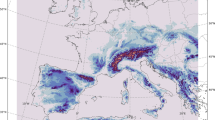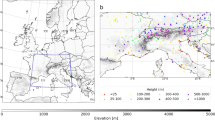Abstract
The issue of Regional Climate Model (RCM) domain size is studied here by using a perfect-model approach, also known as the Big-Brother experiment. It is known that the control exerted by the lateral boundary conditions (LBC) on nested simulations increases when reducing the domain size. The large-scale component of the simulation that is forced by the LBC influences the small-scale features that develop along the large-scale flow. Small-scale transient eddies need space and time to develop sufficiently however, and small domains can impede their development. Our tests performed over eastern North America in summer reveal that the small-scale features are systematically underestimated over the entire domain, even for domain as large as 140 by 140 grid points. This result differs from that obtained in winter where the small scales were mainly underestimated on the west (inflow) side of the domain. This difference is due to the circulation regime over Eastern Canada, which is characterized by weak and variable flow in summer, but strong and westerly flow in winter. For both seasons, the small-scale transient-eddy amplitudes are systematically underestimated at higher levels, but this problem is less severe in summer. Overall the model is more skilful in regenerating the small scales in summer than in winter for comparable domain sizes, which can be related to the weaker summer flow and stronger physical processes occurring in this season.









Similar content being viewed by others
References
Antic S, Laprise R, Denis B, de Elía R (2004) Testing the downscaling ability of a one-way nested regional climate model in regions of complex topography. Clim Dyn 23:473–493
Arakawa A, Lamb VR (1977) Computational design of the basic dynamical process of the UCLA general circulation model. Methods in Computational Physics, vol 17, Academic Press, pp 173–265
Bechtold P, Bazile E, Guichard F, Mascart P, Richard E (2001) A mass flux convection scheme for regional and global models. Q J Roy Meteorol Soc 127:869–886
Biner S, Caya D, Laprise R, Spacek L (2000) Nesting of RCMs by imposing large scales. In: Research activities in Atmospheric and Oceanic Modelling, WMO/TD—No. 987, Report No. 30, 7.3-7.4
Boer GJ, McFarlane NA, Laprise R, Henderson JD, Blanchet JP (1984a) The Canadian Climate Centre spectral atmospheric general circulation model. Atmos-Ocean 22(4):397–429
Boer GJ, McFarlane NA, Laprise R (1984b) The climatology of the Canadian Climate Centre General Circulation Model as obtained from a five-year simulation. Atmos-Ocean 22(4):430–473
Boer GJ, McFarlane NA, Lazare M (1992) Greenhouse gas-induced climate change simulated with the CCC second-generation General Circulation Model. J Clim 5(10):1045–1077
CAS/JSC WGNE (1998) Report of the fourteenth session of the CAS/JSC working group on numerical experimentation. No. 14, 28pp
CAS/JSC WGNE (1999) Report of the fifteenth session of the CAS/JSC working group on numerical experimentation. No. 15, 31pp
Castro CL, Pielke RA Sr, Leoncini G (2005) Dynamical downscaling: an assessment of value added using a regional climate model. J Geophys Res (Atmospheres) 110:D05108. doi:10.1029/2004JD004721
Caya D, Laprise R (1999) A semi-implicit semi-Lagrangian Regional Climate Model: the Canadian RCM. Mon Wea Rev 127:341–362
Christensen JH, Machenhauer B, Jones RG, Schär C, Ruti P et al (1997) Validation of present-day regional climate simulations over Europe: LAM simulations with observed boundary conditions. Clim Dyn 13:489–506
Davies HC (1976) A lateral boundary formulation for multi-level prediction models. Q J Roy Meteor Soc 102:405–418
de Elía R, Laprise R, Denis B (2002) Forecasting skill limits of nested, limited-area models: a perfect-model approach. Mon Wea Rev 130:2006–2023
Denis B, Côté J, Laprise R (2002a) Spectral decomposition of two-dimensional atmospheric fields on limited-area domains using the discrete cosine transform (dct). Mon Wea Rev 130:1812–1829
Denis B, Laprise R, Caya D, Côté J (2002b) Downscaling ability of one-way nested regional climate models: the big-brother experiment. Clim Dyn 18(8):627–646. doi:10.1007/s00382-001-0201-0
Denis B, Laprise R, Caya D (2003) Sensitivity of a regional climate model to the resolution of the lateral boundary conditions. Clim Dyn 20(2):107–126. doi:10.1007/s00382-002-0264-6
Diaconescu EP, Laprise R, Sushama L (2007) The impact of lateral boundary data errors on the simulated climate of a nested regional climate model. Clim Dyn 28(4):333–350. doi:10.1007/s00382-006-0189-6
Dimitrijevic M, Laprise R (2005) Validation of the nesting technique in an RCM and sensitivity tests to the resolution of the lateral boundary conditions during summer. Clim Dyn 25:555–580
Gal-Chen T, Somerville RC (1975) On the use of a coordinate transformation for the solution of the Navier-Stokes equations. J Comput Phys 17:209–228
Giorgi F, Bates GT (1989) The climatological skill of a regional model over complex terrain. Mon Wea Rev 117:2325–2347
Giorgi F, Marinucci MR, Bates G (1993) Development of a second-generation regional climate model (RegCM2). Part II: convective processes and assimilation of lateral boundary conditions. Mon Wea Rev 121:2814–2832
Jones RG, Murphy JM, Noguer M (1995) Simulation of climate change over Europe using a nested regional-climate model. I: assessment of control climate, including sensitivity to location of lateral boundaries. Q J Royal Meteorol Soc 121(526):1413–1449
Køltzow M, Iversen T, Haugen JE (2008) Extended big-brother experiments: the role of lateral boundary data quality and size of integration domain in regional climate modelling. Tellus A 60(3):398–410. doi:10.1111/j.1600-0870.2008.00309.x
Kornic D, Leduc M, Laprise R (2011) The sensitivity of regional climate simulations to domain size and large-scale driving technique. Clim Dyn (submitted)
Laprise R, Kornic D, Rapaić M, Šeparović L, Leduc M, Nikiéma O, Di Luca A, Diaconescu E, Alexandru A, Lucas-Picher Ph, de Elía R, Caya D, Biner S (2011) Considerations of domain size and large-scale driving for nested Regional Climate Models: impact on internal variability and skill at developing small-scale details. In: Climate Change at the Eve of the Second Decade of the Century, Proceedings of the Milutin Milankovitch Anniversary Symposium, Belgrade, 22–25 September 2009 (accepted)
Leduc M, Laprise R (2009) Regional climate model sensitivity domain size. Clim Dyn 32(6):833–854. doi:10.1007/s00382-008-0400-z
Lucas-Picher P, Caya D, de Elía R, Laprise R (2008) Quantification of the lateral boundary forcing of a regional climate model using an aging tracer. Mon Wea Rev 136:4980–4996
McFarlane NA, Boer GJ, Blanchet JP, Lazare M (1992) The Canadian climate centre second-generation general circulation model and its equilibrium climate. J Clim 5(10):1013–1044
Miguez-Macho G, Stenchikov GL, Robock A (2004) Spectral nudging to eliminate the effects of domain position and geometry in regional climate model simulations. J Geophys Res 109:D13104. doi:10.1029/2003JD004495
Paquin D, Caya D (2000) New convection scheme in the Canadian Regional Climate Model. In: Ritchie H (ed) Research activities in Atmospheric and Oceanic Modelling, WMO/TD-No. 987, Report No. 30, 7.14-7.15
Rapaić M, Leduc M, Laprise R (2010) Evaluation of the internal variability and estimation of the downscaling ability of the Canadian Regional Climate Model for different domain sizes over the north Atlantic region using the Big-Brother experimental approach. Clim Dyn 1–23. doi: 10.1007/s00382-010-0845-8
Riette S, Caya D (2002) Sensitivity of short simulations to the various parameters in the new CRCM spectral nudging. Research activities in Atmospheric and Oceanic Modelling. In: Ritchie H (ed), WMO/TD—No 1105, Report No. 32, 7.39-7.40
Rinke A, Dethloff K, Cassano JJ, Christensen JH, Curry JA et al (2006) Evaluation of an ensemble of Arctic regional climate models: spatiotemporal fields during the SHEBA year. Clim Dyn 27:459–472
Robert A, Yakimiw E (1986) Identification and elimination of an inflow boundary computational solution in limited area model integration. Atmos-Ocean 24:369–385
Taylor K (2001) Summarizing multiple aspects of model performance in a single diagram. J Geophys Res 106(D7):7183–7192
von Storch H, Langenberg H, Feser F (2000) A spectral nudging technique for dynamical downscaling purposes. Mon Wea Rev 128:3664–3673
Yakimiw E, Robert A (1990) Validation experiments for a nested grid-point regional forecast model. Atmos-Ocean 28:466–472
Acknowledgments
This research was done within the Canadian Regional Climate Modelling and Diagnostics (CRCMD) Network, funded by the Canadian Foundation for Climate and Atmospheric Sciences (CFCAS), the Ouranos Consortium for Regional Climatology and Adaptation to Climate Change, and the Fonds Québécois de la Recherche sur la Nature et les Technologies (FQRNT). The first author was also supported in part by UQAM’s studentship program Fonds à l’Accessibilité et à la Réussite des Études (FARE). We would like to thank Mr Mourad Labassi for maintaining a user-friendly local computing facility. Thanks are also extended to the Ouranos Climate Simulation Team for their support of the CRCM software.
Author information
Authors and Affiliations
Corresponding author
Rights and permissions
About this article
Cite this article
Leduc, M., Laprise, R., Moretti-Poisson, M. et al. Sensitivity to domain size of mid-latitude summer simulations with a regional climate model. Clim Dyn 37, 343–356 (2011). https://doi.org/10.1007/s00382-011-1008-2
Received:
Accepted:
Published:
Issue Date:
DOI: https://doi.org/10.1007/s00382-011-1008-2




